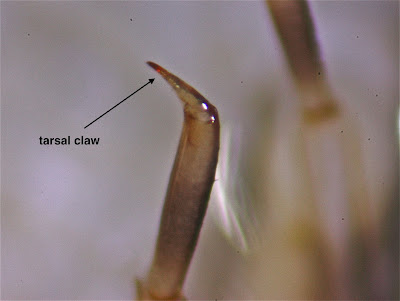Tuesday, December 13, 2011
Working Out Flatheaded Mayfly ID: Maccaffertium meririvulanum
On Sunday (December 11) I noted that this flatheaded mayfly that I found in that tiny stream in Sugar Hollow looked a little bit different to me -- in terms of color and pattern. The pale yellow color, the "V's" on the abdominal segments, and the pronounced banding on the legs (the femorae), made me want to look into species ID. I did some microscope work yesterday, and I feel fairly confident that this is Maccaffertium meririvulanum, which Beaty notes is "a small mountain stream taxon." The tolerance value for M. meririrvulanum is 0.5.
Let's make the case, and I may as well start with Beaty's description. "M. meririvulanum -- nymphs 10-16 mm; no hairs and 7-10 spine-like setae on maxillary crown; terga with distinct V-shaped pale mark on 5 and either 7 or 8, or 7-9; claws without denticles." ("The Ephemeroptera of North Carolina," p. 19.)
1) This is a young nymph -- look at the "short" wing pads -- still, it measured out to 9 mm.
2) The "maxillary crowns" (if you've forgotten what these are and their location, look back to "The Big Mac Problem," posted on 10/6) do indeed have no hairs, and each has 7 "spine-like setae." You can actually count them.
3) The terga have pale "V's," in this case, on segments 4 and 5, and 7-9. These are visible in the live photos, but here is a microscope view.
And 4) there are no denticles on the tarsal claws.
So I feel pretty good about this ID. I've shown Beaty the photos and he concurs. However, he cautions that we can't be sure of the ID until we see mature nymphs: patterns -- as we know -- change during the process of maturation.
Two additional photos.
And a reminder of the size of the stream in which this nymph was found.
Subscribe to:
Post Comments (Atom)







No comments:
Post a Comment